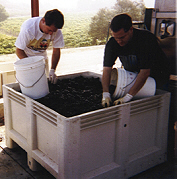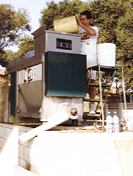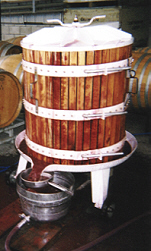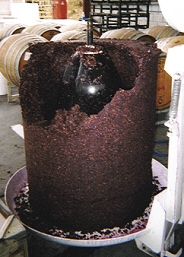Vineyard Activities
My philosophy is that what happens in the vineyard determines the quality of the wine. Great grapes picked at the right time plus no screw-ups in the winery equals good wine. Rather than try to describe what happens in the vineyard myself, I'll instead refer you to one of my sources of killer Pinot, Wes Hagen at Clos Pepe Vineyard.
When it's time to pick, I'm right there in the vineyard with the pickers, sorting through the clusters as they're dumped into the bins. I try to remove any "bad" looking fruit and as many leaves as possible. It's impossible to be perfect, since we're often picking before dawn and the pickers move very fast! But not to fear... there's another chance to sort a bit later.
Crush


Once the grapes are picked and back at the winery, I get to sort through the grapes again, discarding any clusters that show obvious signs of mold or raisins. The actual amount of fruit discarded is usually pretty low given that I've already done a rough pre-sort in the vineyard. I'm also careful to remove any leaves that might have made it past me in the vineyard. Grape leaves might be a tasty component in Greek food, but you really don't want them in your wine! And no, we don't wash the grapes prior to crushing. Those little suckers would just soak up the water resulting in a diluted product. And besides, it's the dirt and spider webs that add that little extra complexity we all enjoy!
The sorted fruit is then dumped into the top of the crusher/destemmer. The clusters are fed horizontally through a perforated metal cylinder by a set of rotating paddles. Through some combination of the wacking of the clusters by the paddles, the holes in the cylinder, and some other magic the grapes are separated from the stems. The stems proceed out the end of the device, and the grapes fall through to the bottom where they are crushed by a set of rollers. The resulting slurry of juice, skins, and seeds (must) is fed out the bottom where we collect it back into the macro bins for fermentation.
I always totally destem my fruit. Why? I could say that I don't want the extra or maybe bitter tannins that stems add to the wine. But I think the real reason goes back to childhood - when I decided that I didn't like vegetables - a dislike that persists to this very day. When I see stems, I see green, and green means vegetables - so NO STEMS!
Fermentation
In order to maximize the color extraction from the skins, we perform a "cold soak". By lowering the temperature to around 50 degrees, we prevent the fermentation from starting. After a few days, we allow the mixture to warm up and innocculate with yeast. You could choose instead to allow the "native" yeast to do the fermentation. During the cold soak and subsequent fermentation, it's important to keep "punching down" the skins which float to the top. This is done to increase extraction as well as keep the skins from drying out, which is a major source of bad bacteria.

Pressing


Once the fermentation is complete, it's on to pressing. Since we do such small lots of wine, we use a basket press. We take our trusty 5 gallon buckets and scoop up the juice, skins, and seeds from the bins and pour it into the top of the press. The juice flows out through the slats and the bottom and is then pumped into a tank. Once the press is full of skins, we shut the top and slowly inflate the central air bladder. This gently presses the skins (without breaking the seeds) and liberates the remaining juice. The last bit of juice, or as we call it "hard press", is kept separate from the other juice. It's aged in separate barrels and may or may not be blended into the final wine, depending upon taste.
The air bladder presses the skins outward, against the wood slats. So, when you're done pressing and deflate the bladder, what's left is a cylindrical wall of skins. It's really amazing to see for the first time. And it's kinda fun to break apart! The pressed wine goes directly into barrels and then into the caves.
Barrel Aging

Pinot Noir really needs time in the barrel. Some varietals, like Cabernet Sauvignon and Merlot, taste great out of the press. Pinot's not so immediately "accessible". The choice of barrels for Pinot Noir is absolutely limited to French Oak. No exceptions! The barrel maker, which forest in France the wood comes from, and the toast level are decisions left open to the winemaker. I personally like Francois Freres and Sirugue barrels, various sources, and all medium toast - thank you very much. I use approximately 50% new and 50% reused barrels. After the wine has finished its primary fermentation in the barrel, a secondary fermentation is allowed to take place. The secondary, or malolactic (ML) fermentation is where the malic acid is converted to lactic acid. ML fermentation is necessary to help stabilize the wine and help prevent the need for filtering prior to bottling.
I'm very lucky in that I get to store my barrels in the caves at Cottonwood Canyon. The low, constant temperature provides the ideal condition to age wine.
Producing Tasty Pinot Noir since 1999 WITHOUT the "benefit" of ISO 9000 Certification!